Mold on Food
We all grow up learning mold is gross. But is it just unpleasant, or is it actually dangerous? Isn’t it mold that makes blue cheese blue? And wasn’t penicillin first discovered in moldy bread?
Are we wasting perfectly safe food when we throw it out? Or are we gambling our health when we shrug our shoulders and eat that piece of cheese that had a dusting of white fuzz?
Let’s look at the facts.
What is mold on food?
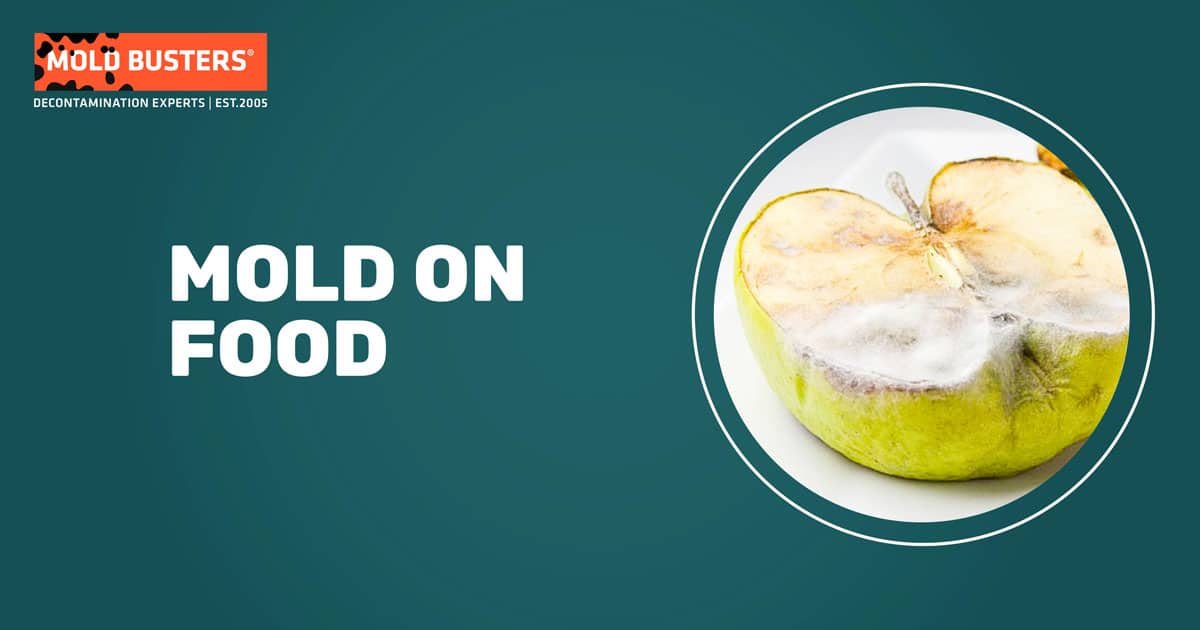
Mold is a microscopic fungus, and yes—spoilers!—consuming it can be bad for our health. Like its cousin the mushroom, there are thousands of different species.
Some are safe to consume, but many produce poisonous mycotoxins that cause illness and even death. Additionally, some people are allergic to mold and need to steer clear of it. So dealing with mold on food is serious business. If you’re in the Montreal area and suspect you have a mold issue, our Montreal Mold Busters team can help you address it.

Why does mold grow on food?
Mold requires three things to grow: organic matter, water and oxygen. Food provides the the first two ingredients. Exposed to air, mold has everything it needs to grow.
How does mold grow on food?
Tiny mold spores are carried in the air. When these spores land on food, they take root and grow until they produce patches of mold visible to the naked eye. Once they mature, they produce new spores and release them into the environment and the cycle continues.
How long does it take for mold to grow on food?
Many factors affect the rate of growth of mold: the specific type of mold, the food it’s growing on, and the ambient temperature and humidity. Many species of mold like warmer temperatures and mold growing on fruit on your counter may develop in very few days, especially in the warm humid summer months. Other mold growing on food with less water content in the cool of a refrigerator might take several weeks.
How to handle mold on food?
Mold can grow on most types of food, but not all food is the same.
Red Flag Food
Red flag food items should be automatically discarded when moldy. These items include most food items, particularly soft and moist foods:
- Luncheon meats, hot dogs, bacon, etc.
- Cooked leftover meat, poultry and fish
- Cooked pasta and cooked grains
- Casseroles
- Sour cream and yoghurt
- Soft fruits such as tomatoes, berries, cucumbers, etc.
Some other drier, harder foods fall into this category as well:
- Nuts and legumes
- Bread, baked goods and other highly porous items
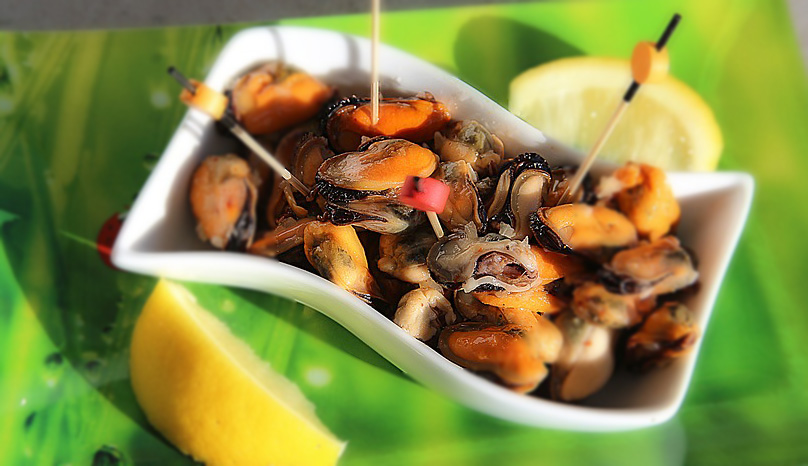
In general, softer food with more moisture content is more prone to molding, and can’t be safely salvaged. In addition to the mold itself, soft moist food can provide an ideal environment for dangerous bacteria to grow. For these foods, it’s important not to assume the problem is limited to the mold you see.
Throw away the moldy food, and carefully inspect other nearby food, especially food in the same package. Do not sniff moldy food: spores might get into your respiratory system. Wrap the spoiled items in plastic to contain the spores, and discard. If you’re based in Ottawa, our Ottawa Mold Busters team is ready to assist you in dealing with mold issues.
Cheeses made with mold
Cheese often incorporates mold as part of its production. However, it’s crucial to distinguish between intentional and potentially harmful molds. Here’s a guide to some popular cheeses and their relationship with mold.
| Cheese Type | Mold Used in Production | Action if Other Mold Detected | Safe to Consume if Moldy? |
|---|---|---|---|
| Blue Cheese | Penicillium roqueforti | Discard if unsure | Yes, but only the intentional mold |
| Brie | Penicillium camemberti | Discard if mold on surface | Only if mold is part of production |
| Roquefort | Penicillium roqueforti | Discard if unsure | Yes, but only the intentional mold |
| Gorgonzola | Penicillium glaucum | Discard if unsure | Yes, but only the intentional mold |
| Stilton | Penicillium roqueforti | Discard if unsure | Yes, but only the intentional mold |
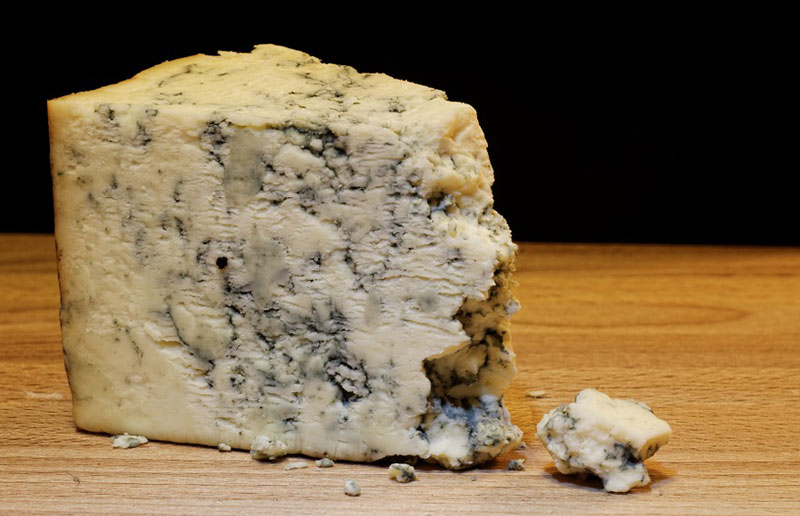
The mold used in making these cheeses is safe for consumption. However, if other mold that is not part of the manufacturing process is present, these items should be discarded just like any other red flag food item. Some blue cheeses may be hard enough to be treated as a Yellow Flag item (see below for care). However, if you are unsure where to draw the line, remember: when in doubt, throw it out.
Note that while the mold that forms the blue veins inside blue cheeses is harmless when deprived of oxygen inside the cheese, the same strain of mold can form harmful mycotoxins if allowed to grow on surfaces exposed to air. Be careful of cross-contamination with these cheeses and keep them wrapped in cellophane while storing them.
Yellow Flag Food
Other foods, particularly harder and drier foods, can sometimes be kept once the mold is carefully removed. These include:
- Hard cheese
- Firm fruits and vegetables (cabbage, carrots, bell pepers, etc.)
- Hard salami and dry-cured ham
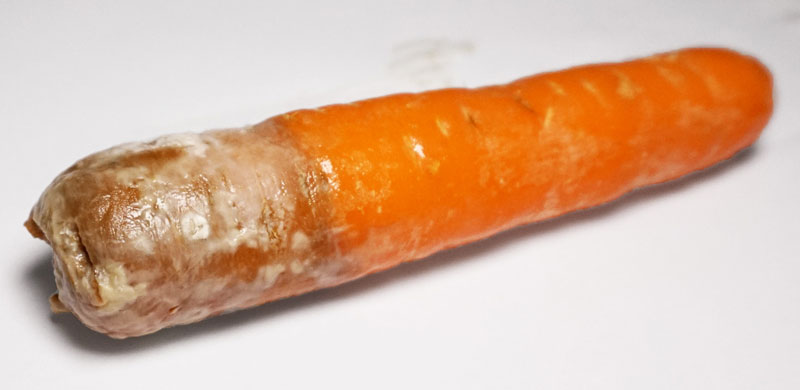
If you’re going to cut away mold rather than discard the item, it’s important to remember that there is more mold present than what you can see. Below the surface, mold will have penetrated up to 2cm or more. For these food items, mold can be cut away but you should cut at least 2.5cm (1 inch) outside of and underneath any visible surface mold. Be careful to keep the knife clear of the mold to avoid contaminating the rest of the food as you cut.
Note that surface mold is a normal occurrence on certain hard salamis. In this case, scrubbing the mold off the surface is sufficient. Again, it never hurts to be cautious. When in doubt, throw it out.
Types of mold on food
There are numerous types of mold that can grow on food. Some food molds are beneficial and used in producing certain foods, like blue cheese. However, molds prefer warmer temperatures and can grow on various foods, from soft cheese to bell peppers. It’s crucial to recognize and differentiate between harmless and harmful mold. For instance, while some molds on hard cheeses can be scrubbed off, moldy soft cheese should be discarded immediately.
Here’s a breakdown of common mold types found on food and their potential impacts.
| Mold Color | Common Foods Affected | Action Recommended | Potential Health Risks |
|---|---|---|---|
| Black | Bread, fruits, refrigerator seals | Discard immediately | Respiratory issues, allergies |
| Pink | Bread, dairy products, meat | Discard immediately | Respiratory, gastro-intestinal infections |
| White | Berries, cheeses, fruits | Check if intentional (like in Brie) or discard | Allergies, mycotoxin production |
| Green | Citrus fruits, bread, salads | Discard immediately | Respiratory problems, vomiting |
| Orange | Wood, some fruits | Discard and clean area | Respiratory problems |
| Red | Various foods | Treat with caution and discard if unsure | Potential mycotoxin production |
| Blue | Bread, cheeses | Check if intentional (like in blue cheese) or discard | Mycotoxin production if exposed to air |
Black mold on food
Various strains of mold can have a black appearance. Homeowners know to watch out for black toxic mold, Stachybotrys chartarum, commonly found in attics.
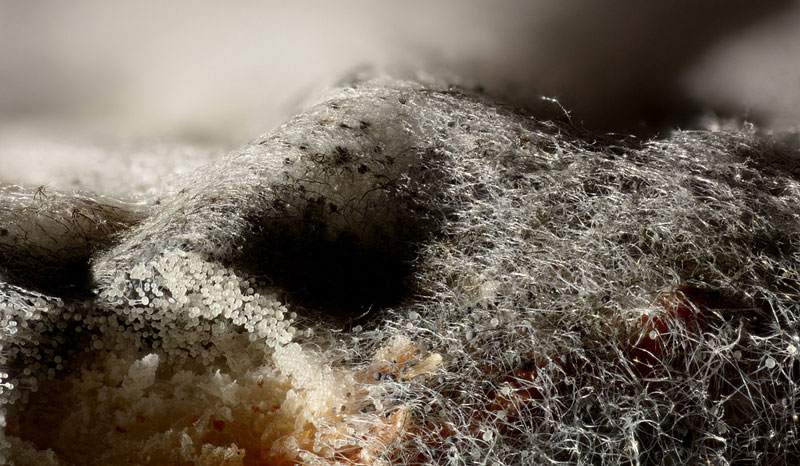
However there are many non-toxic strains of black mold as well, including Rhizopus stolonifera, also known as black bread mold. You may encounter black mold on the rubber seals of your refrigerator or on food. While this doesn’t prove you have black toxic mold in your house, you are best to assume it may be harmful and discard the food item in question, meticulously scrub clean the refrigerator, and look for signs of black mold in your house.
Can black mold grow on food?
Yes, black mold can grow on food. While it’s commonly found on walls and ceilings, it can also grow on food, especially if the conditions are right. Foods with high moisture content, like green and mixed salads, are particularly susceptible. If you spot black mold on any food item, it’s best to discard it immediately.

Did you know?
Stachybotrys is the 3rd common toxic mold type found in homes we tested?! Find out more exciting mold stats and facts inside our mold statistics page.
Pink mold on food
Pink moldy formations on food may not be mold at all, but rather bacteria growing. Aureobasidium and Fusarium are also two common fungi that grow with a pinkish colour.
Pink mold is most often seen on bread, dairy products and meat. Dangers of pink mold include infection of the respiratory, gastro-intestinal or urinary tracts.
White mold on food
White mold is seen on a variety of foods, from the white mold purposefully grown on the outside of certain cheeses, to fluffy white mold appearing on berries and other fruit.
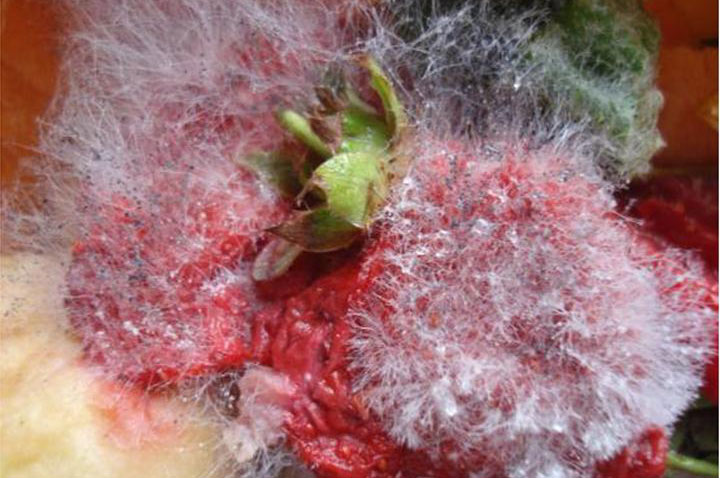
Many strains of mold can appear white, and to complicate matters many coloured strains of mold may go through a phase where they appear white before developing the spores that give them their colour. Unless white mold is a purposeful part of a food’s production (e.g. brie and camembert cheese), assume it is toxic and handle affected food accordingly.
Green mold on food
Green mold is commonly found on citrus fruit and bread. Cladosporium is one particularly common species of green mold.
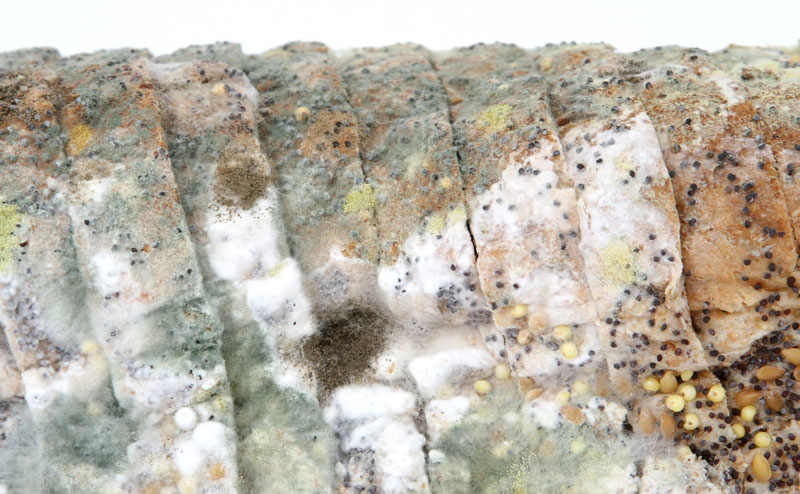
It can have a potent smell and be particularly irritating, particularly for people with mold allergies. This can lead to respiratory problems such as wheezing and coughing, as well as vomiting. Clodosporium mold can produce mycotoxins as well, so avoid exposure.
Orange mold on food
A variety of mold can take on an orange colour, including Fuligo septica and Aleuria aurantia. These orange molds commonly have a slimy texture.
While they may be less dangerous than some other colours of mold, they can still cause respiratory problems, and where orange mold is present, bacteria are also likely to be found.
Furthermore, orange mold is particularly prone to growing on wood. So not only is orange mold a threat to your food, it is a threat to the wood in your house.
Red mold on food
While various strains of mold can be red, red mold on food is most commonly Neurospora. While this type of mold is typically less dangerous than other types of mold, some mycotoxin-producing molds might appear red in certain conditions, or might be present alongside red mold. It’s therefore wisest to treat red mold on food with the same caution as other mold.
Blue mold on food
Blue mold on bread and the blue mold deliberately cultivated to make blue cheese are strains of the genus Penicillium. And yes, some species of Penicillium (but not all!) produce penicillin. Many species of Penicillium are innocuous, but some are not.
And while the blue mold in blue cheese, deprived of oxygen, is safe for consumption, that same strain of mold can produce mycotoxins when it grows on an outside surface exposed to air. So, eat that blue cheese but treat other blue mold as potentially toxic.
What happens if you eat mold?
Is it dangerous to inhale mold spores from food?
Inhaling mold visible on food is risky and should be avoided. It may cause allergic reactions or problems with the respiratory tract. When mold isn’t visible, sniffing may be a useful way to detect it—e.g. smelling dishcloths. However, once you’ve spotted mold, avoid inhaling.
Can mold on food make you sick?
Mold on food can be harmful in various ways. Some people are allergic to mold and could have a potentially serious reaction. However, even if you don’t have allergies, mold can cause irritation in the respiratory, gastro-intestinal or urinary tracts. And the mycotoxins created by some molds are poisonous carcinogens that can prove fatal. To ensure your safety, consider our virtual inspection services to identify potential mold issues in your home.
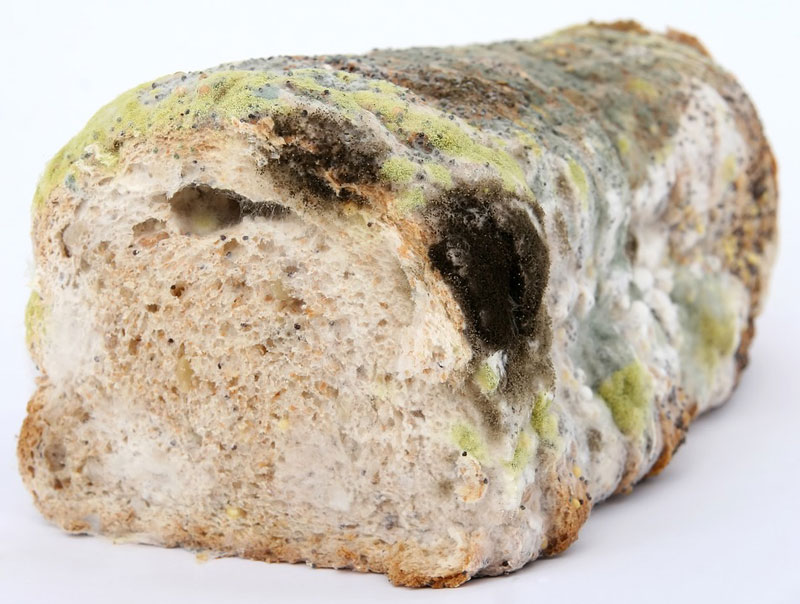
What are health symptoms you can get by eating mold on food?
Allergic reactions to mold can include sneezing, runny or stuffy nose, coughing, postnasal drip, irritated eyes, nose and throat and dry, scaly skin. Those with asthma may experience coughing, wheezing, shortness of breath and tightness in the chest.
Those without allergies may still experience respiratory problems such as wheezing, sneezing, tightness in the chest and difficulty breathing. In more severe cases, this can lead to respiratory infection and even hypersensitivity pneumonitis.
A particular concern is ingesting mold that produces mycotoxins. Signs of mycotoxin poisoning include reduced appetite, a general feeling of malaise, acute illness or death in rare cases.
Food mold facts and questions
Which food will mold fastest?
Storage conditions will have a significant effect on how quickly a given food turns moldy. However, all things being equal, food with a high moisture content will mold first. Thus, in the fridge, fruits such as strawberries or cucumber might get moldy before other foods. Stored at room temperature, natural bread (with no preservatives) can get moldy quite quickly.
Is it safe to eat fruits with mold on a peel you discard?
It may be tempting to think that for fruit with a peel, simply removing and discarding the peel may be enough to protect you. In the case of a firm fruit like a pineapple, it can indeed be treated as a “yellow flag” food, carefully cutting away the affected area.
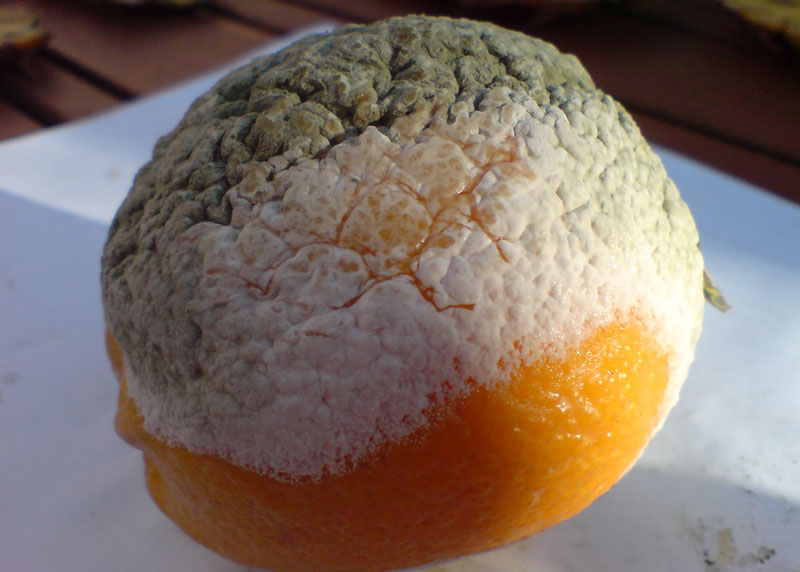
Fruits with a softer peel like oranges or bananas should be treated as “red flag” foods and discarded—underneath the visible mold, it may have penetrated the peel to the flesh of the fruit inside. In the case of an avocado, while the skin is quite tough mold can still get underneath and infect the fruit inside. Play it safe and discard it.
Can you kill mold by cooking it?
If you wonder does cooking kill mold, you should know that the viability of mold can be disrupted by thermal energy, such as heat from cooking. This will kill the mold and make it unable to grow or spread. However, it is important to note that not all molds are killed by heat. Additionally, any remnants of the moldy food still present in the kitchen after cooking should be cleaned and sanitized to prevent future growth.
Does heat kill mold?
Yes, heat can kill mold. However, while heat can eliminate mold growth on various foods, the toxins produced by certain molds might remain. For instance, when considering grain and nut crops, exposure to high temperatures can reduce mold presence, but the poisonous substances produced might still linger. The Food and Agriculture Organization has guidelines on how to handle such situations to ensure the world’s food crops remain safe for consumption.
Mold response to heat
To understand how heat affects mold, let’s look at common heat treatment methods and their impact on mold and mycotoxins.
| Treatment Method | Effect on Mold | Effect on Mycotoxins | Commonly Used For |
|---|---|---|---|
| Boiling Water | Kills most molds | May not neutralize | Sterilizing utensils, cooking pasta |
| Toasting | Kills mold on surface | May not neutralize | Bread, bagels |
| Baking | Kills most molds | May not neutralize | Pastries, bread |
| Cooking Cheese | Kills mold and bacteria | May not neutralize | Soft and hard cheeses |
Does boiling water kill mold?
Yes, boiling water kills most molds. However, while boiling can eliminate microscopic fungi, the mycotoxins they produce might still be present. It’s always advisable to discard foods, especially perishable foods, that have visible mold growth to ensure safety.
What temperature kills mold spores in food?
Most molds are killed off by temperatures of 60-70°C (140-160°F). Thus, boiling water is generally enough to kill off mold. Remember, though, that mold doesn’t just grow on the surface: heat will have to penetrate into whatever the mold is growing in to kill it. Also keep in mind that the mycotoxins produced by certain mold can survive intense heat: boiling may kill the mold but leave its poisons still intact.
Will cooking moldy cheese kill bacteria?
Yes, cooking moldy cheese can kill the mold and bacteria. However, it doesn’t neutralize the toxins they’ve produced. Soft cheeses, like cream cheese and brie, are particularly susceptible to mold growth. If you find mold on such cheeses, it’s best to discard them. On the other hand, hard cheeses can sometimes be salvaged by cutting away the moldy part. However, always exercise caution and when in doubt, discard the cheese.
Does heat kill mold on bread?
Yes, toasting bread can kill mold. However, while toasting eliminates the mold, it doesn’t neutralize the toxins already produced. Therefore, it’s safer to discard moldy bread entirely to avoid any health risks.
How to prevent mold on food?
Of course, far better than throwing out moldy food is avoiding having your food get moldy to begin with! Fortunately there are steps you can take to keep your food fresh and mold-free:
- It takes one moldy food item to get the whole basket covered in mold! This is very important rule to remember the moment you are at the market. If you are buying nonpacked items, ensure each of them is fresh. If you notice mold on any single piece, simply don’t buy it. Examine each item for bruising, softness, oxidation or signs of mold before you buy it and avoid any items that look overly ripe.
- On the other hand, when buying pre-packed food you cannot examine every single piece, meaning that moldy items can go unseen. In that case, ensure you checked the date and chose the one that was most recently packed. Instead of buying processed or pre-packed food, where you often don’t have control of the freshness (the story of wrong dates is not rarely heard), choose local markets and stores you can trust.
- Once you buy your delicious food, especially fresh fruit and veggies, it is important to keep it covered until you’re ready to eat it to minimize the risk of cross-contamination with bacteria, mold, dust and debris from the environment. Use plastic wrap to cover foods you want to keep for longest, such as fresh fruits, vegetables, salads and cheese.
- Rinse the contents of canned goods under water and store them in your fridge in tightly sealed plastic or glass containers. Refrigerate leftovers and use them within four days.
- Consume early to avoid mold. The first step you can take to prevent food going bad is to eat it before mold has time to take hold. Especially for moisture-rich and porous food like fruits and breads, buy in smaller quantities so you can consume it within a just a few days.
- Keep food cold: the cooler the better. Keep food, especially soft moist food like fruit, in the refrigerator rather than at room temperature. Only take it out while you’re using it—under two hours. To keep food mold-free for longer periods, store it in the freezer rather than the fridge.
- Use heat to kill mold. High acid foods such as fruits, jams and jellies can be made safe to preserve through heat treatment. A boiling water bath is a common practice to prepare them for a long shelf-life. The amount of time required for a water bath will vary depending on what and how much you’re canning, so be sure to adapt your method to the specific food you’re treating.
- Keep kitchen tools and surfaces clean. Mold may thrive on food, but it can be found anywhere. The less mold in your kitchen, the less your food will get exposed. Clean your refrigerator and other kitchen surfaces with a mixture of 5ml of baking powder to 1L of water. Watch out for black-coloured mold on your fridge’s rubber seals and scrub carefully to clean it out.
- Keep your dishcloths, tea towels, sponges, mops and other kitchen tools clean. Give them the sniff test: if they smell musty, they may be harbouring mold. Any item that you can’t get clean and fresh-smelling, discard and replace.
Food storage recommendations
Proper storage is key to preventing mold growth on food. Here’s a handy guide on how to store various food items to maximize their shelf life and keep them mold-free.
| Food Type | Storage Recommendation | Mold Prevention Tips | Shelf Life |
|---|---|---|---|
| Soft Cheese | Refrigerate, consume quickly | Keep in airtight containers | 1-2 weeks |
| Hard Cheese | Refrigerate, can cut off mold | Store in wax paper or cheese paper | 3-6 weeks |
| Bread | Cool, dry place | Consume quickly, avoid damp storage | 4-7 days |
| Fruits (berries) | Refrigerate | Check regularly, discard moldy pieces | 3-7 days |
| Fruits (citrus) | Cool place or refrigerate | Check regularly | 1-2 weeks |
| Cooked Meat | Refrigerate | Consume within 3-4 days | 3-4 days |
Mold proofing kitchen and cleaning tips
Since food is stored in the kitchen (most of the times), keeping your kitchen clean and well-aired will also have a big impact on your food’s life. For example, mold will develop anywhere where there is a leak, and if you are storing food close to that it can easily transfer from a corner and attack your favorite otherwise fresh food.
In order to prevent mold on food you will have to work on overall kitchen mold prevention. In most cases it includes either ensuring there is enough fresh air or regular cleaning. Here are a few tips that can help you prevent mold in the kitchen.
- As said above – mold can grow in the fridge and, thus, it is important to keep the inside of the refrigerator clean. We suggest cleaning it every few months with one tablespoon of baking soda dissolved in a quart of water. Rinse with clean water and dry thoroughly before storing food again.
- Ensure your food is still fresh by checking it every day or two. Toss away anything that has a sign of mold or that started rotting away.
- Replace sponges at least once a week and always use clean dish clothes and towels. If you notice a musty smell coming from a sponge or towel, replace it immediately.
- Wash the dishes at least once a day. Don’t leave food leftovers in your sink behind you once you are done with the meal. Throw them away immediately. If you are in a rush, keep your dishes under water to prevent food stains from hardening until you can wash them properly.
- Mold can be found in dishwasher and garbage disposals. It can be the reason behind the odors, thus keeping it clean should be your priority. At least once a week pour baking soda, salt and vinegar (or lemon) own the sink and leave it for 10 minutes. You can add lemon or orange peels and even essential oils to give it a nice smell. After that all you have to do is pour boiled water to wash it up and your disposal and sink will be clean, mold-free and refreshed.
- Kitchen tools, especially wooden ones should be washed and well dried before set aside, because wood is one of the favourite food for mold. All you have to do is simply wash them after you used them and leave them to dry well somewhere where it is not wet and it has enough fresh air and light. (for example if you are done with cooking and your stove is still warm, you can put it next to it to dry.
- Don’t forget about unused kitchen appliances. They are often sealed and if not well dried, mold can form due to water evaporation inside. The best way to prevent mold from developing inside is to ensure it is well dried before storing and, if there is a possibility, keep it open.
- And last but not least, make sure that the relative humidity in your home is between 30% and 50%, especially in the warmer months, when mold is known to flourish. The easiest thing you can do to control the humidity level is to keep your windows open as often as possible. If that is not possible your next steps should bes either air vents or even a dehumidifier.
Additional recommendations
Mold is a type of microscopic fungi, and there are many species present in our environment. While some molds are used beneficially in food production, others can be harmful. It’s essential to minimize mold growth in foods by storing them properly. For instance, processed food should be consumed before its expiration date, and animal matter should be refrigerated. Regularly cleaning your kitchen, including other cleaning utensils, can also help in preventing mold. Remember, while certain foods can be salvaged from mold, it’s always best to prioritize health and safety. When you spot mold, especially on soft cheeses or any other food, it’s a general rule to discard it. And always be cautious with grape juice and other liquids, as they can be a breeding ground for mold if not stored correctly.
Conclusion
As with mold in general, there are many strains of mold that can be found on food. While some are innocuous, many are not. While mold that’s purposefully introduced into certain cheeses can be safe, always treat other mold on food as a dangerous substance. Treat “yellow flag” foods with caution and for “red flag” foods, play it safe and discard it.
And remember, the same concerns about mold allergies and mold toxicity that applies to food mold also applies to other mold in your house. Keep watch for mold in your kitchen and whole house, and if you detect signs of mold, get informed as to the steps needed to eradicate it safely.
Resources

Get Special Gift: Industry-Standard Mold Removal Guidelines
Download the industry-standard guidelines that Mold Busters use in their own mold removal services, including news, tips and special offers:
Published: May 19, 2020 Updated: July 3, 2024

Written by:
John Ward
Account Executive
Mold Busters
Fact checked by:
Michael Golubev
CEO
Mold Busters
